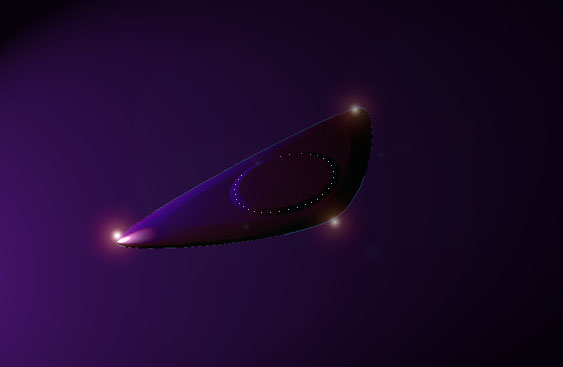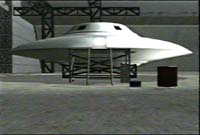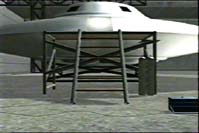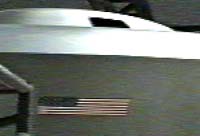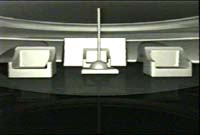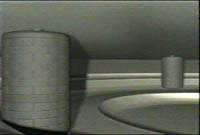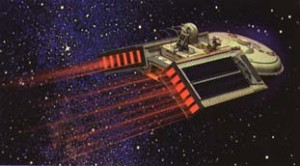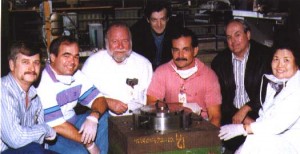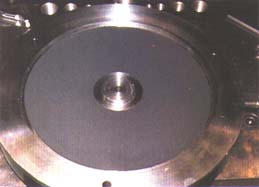Delta UFO, ” The Descent“, ©1996, 1997, Dave Kauble.
ARTICLE BY Dave Kauble
________________________________________
This article focuses on propulsion systems, primarily anti-gravity and anti-matter. Several press releases, scientific articles, and science shows have appeared recently which causes
us to focus on a significant coincidence. This article attempts to spread light on these coincidences. To do so, we’ll focus on several pieces of a larger puzzle. These pieces are a collection of information from various news and television sources. First, we’ll cover the Bob Lazar “revelations”.
S-4, or Papoose Lake, Near Groom Lake, or area 51, or Dreamland, is
the subject of a recent Discovery Channel episode. One of the most interesting
parts of this program centered on the story of Bob Lazar, a jet-propulsion
car builder who claims that he was asked to do research work to back-engineer
technologies on captured alien spacecraft located at S-4. Lazar’s story
has many twists and turns, and has led to much controversy. Although his
story is not new, it parallels other recent announcements and so warrants
discussion in this article.
We are not going to delve into the vagaries of Lazar’s story other than
how it relates to the propulsion concepts of this article and the release
of recent information which closely parallels Lazar’s descriptions. Bob Lazar underwent 4 different lie-detector tests. He passed two, failed two;
making the results somewhat inconclusive. But the interview of one of the
lie-detector analysts on this program leads us to believe, that if not
all of Lazar’s answers were true, his comments about the anti-matter and
anti-gravity technologies related to UFOs in S-4 were absolutely true.
I’m not quoting here, only synopsizing, but Lazar’s comments were that he was initially introduced to one UFO craft. His first reaction was, being shown the craft without any debriefing, that it was the answer to all the UFO enigmas of the past… that WE ( the U.S. Government ) were building and flying these craft and that sightings were of our people flying these craft. The first craft he was shown ( by his account ) displayed an American flag on the outer hull, reinforcing this perception.
Lazar’s first view. (artwork, not photo)
Close-up view. (artwork, not photo)
Flag displayed on hull of UFO (artwork, not photo)
He states that it didn’t take long for his opinion to change. After a while, he was shown the interior of the craft. He described finding 3 different levels, or floors in the craft. Once inside and having viewed the level where it was obvious the craft was piloted, it became obvious to him that the craft was not built for human pilots. The dimensions of the roof and seats were very small and would have been ergonomic ONLY for VERY small personnel.
Interior of the UFO obviates non-human scaling (artwork, not photo)
Devices he described as anti-gravity amplifiers and anti-matter reactors were of sizes that would obviate technologies FAR IN ADVANCE of our own. He described ongoing requests by superiors which progressively led him to believe he was being asked to participate in the back-engineering of these craft for the U.S. Military Intelligence.
Lower level — anti-matter reactors (artwork, not photo)
 He also stated that he was progressively shown more craft of a variety of shapes, but that the technologies involved in these crafts were the same, even though they had different shapes and sizes. He states that he had only closely examined the first craft he was shown, but the successive craft had similar trappings to indicate similar propulsion and power systems.
He also stated that he was progressively shown more craft of a variety of shapes, but that the technologies involved in these crafts were the same, even though they had different shapes and sizes. He states that he had only closely examined the first craft he was shown, but the successive craft had similar trappings to indicate similar propulsion and power systems.
UFOs. (artwork) (note indent on “roof” of tilted UFO, indicating it was struck by a projectile. A shoot-down?)
These were all located in the S-4 research site, which Lazar claims has been relocated since his disclosure. Lazar also stated that he saw more than one such craft actually fly. He described his impressions–that the craft were not being flown expertly, but falteringly, and only in a manner showing that our knowledge of flying and navigating these craft was elementary at best. He stated the craft never left the S-4 airspace. He also stated that this craft are no longer at S-4 and have been moved to another location. Could the new location (or locations) be at underground bases? It seems feasible.
Our second segment to our analysis begins with an article which appears in the January/February issue of Final Frontier, the bi-monthly science and science-fiction publication.
This information, as well as the information that AP released last Fall
about the accidental discovery of anti-matter 50 YEARS AGO (see this release
in our text box on the New Items Page) and that this was recently reproduced
in a linear accelerator, coupled with the research NASA personnel and
other research groups have done with anti-gravity and magnetic field propulsion
(see our note about this relating to super conducting magnetic field research,
also in our text box) certainly show the parallels of what Lazar has stated
within the past few years and what we are now seeing in the news. Perhaps
these research organizations sincerely know nothing about UFO technology
back-engineering. Perhaps they DO. Perhaps they are being selectively fed
information or are being carefully guided into these research areas because
they have been guided to these paths coherently.
True, this is conjecture. But only by asking and being aware can we find out the truth. Read this article, check the items we have in our text box on the “News Items” page and the other linked article, and then decide for yourself.
Steps to the Stars: First things first.
(article from Final Frontier, Jan/Feb issue)
Later in 1997, the Breakthrough Propulsion Physics program will host an invitation-only workshop. At the gathering, scientists will examine relevant emerging physics. They will also brainstorm a list of next-step research tasks, says NASA’s Millis.
To be surveyed are a host of theories, physical evidence and anomalous effects that have recently emerged but have not yet been rigorously assessed.
“There have been recent theories published in peer-reviewed literature suggesting new connections between inertia, gravity and electromagnetism. There’s even a theory for a ‘warp drive,’ but physicists aren’t even sure if such breakthroughs are possible,” Millis says.
“If the workshop successfully demonstrates that promising and affordable approaches exist,” he continues. “funding may be granted to begin conducting the step-by-step research that may eventually lead to the breakthroughs.”
In other words, while you’re reaching for the stars, don’t forget to stoop for a little reality.
If you want to get anywhere fast in this old universe, there arc three technologies required for 21 st century space missions. “These technologies are propulsion, propulsion and propulsion,” points out Robert Frisbee, manager of advanced propulsion technology at the Jet Propulsion Laboratory (JPL) in Pasadena, California.
Moreover, physics today is teeming with conjecture showing us that scientists clearly don’t know everything. Frisbee says that the physics community is rife with people studying time machines, wormholes and warp drives by looking at Albert Einstein’s equations and putting them through the ringer.
“These are things we used to think of as solely the province of science fiction,” with work now being done by reputable physicists, publishing in peer-reviewed journals, the JPL scientist says.
A member of the breakthrough propulsion physics product definition team, Frisbee underscores the fact that studying such topics as faster-than-light travel, leaping across space and time via wormhole, anti-gravity and other research tracks, is a high risk activity.
“But in terms of trying to get us out of our existing paradigm, this type of work is very important. The payoff could totally revolutionize the way we look at nature, in the same way that relativity and quantum mechanics changed the way we looked at the universe almost a hundred years ago,” Frisbee contends.
Coupled to his optimism, Frisbee tags a note of warning. “You have to be careful of situations where you get into ‘pathological science.’ That is when you ate trying to treasure some tiny, tiny effect, but where wishful thinking gives you the answer and not the actual experiment,” he cautions.
What are the odds of discovering some radical, new form of physics’?
“Chances are very high we won’t find anything,” says Franklin
Mead, Jr.. senior scientist in the propulsion sciences division of the
Air Force’s Phillips Laboratory at Edwards Air Force Base, California.
“But there’s also that very small chance of stumbling on something
that will have a very large payoff. It’s important to look for that needle
in the haystack…that diamond in the rough that hasn’t been found. But
it’s very difficult to succeed,” Mead says.
Also a member of NASA’s breakthrough propulsion physics product definition
team, Mead has funded a variety of advanced propulsion ideas over the years.
From anti-proton propulsion, space warps, beamed energy and fusion rockets
to space tethers and faster- than-light travel- all have received top billing
on Mead’s research list at one time or another.
“You have to keep looking…you need to turn over every rock,” Mead says. Furthermore, as new materials become available, these ideas, and others, deserve second looks from time to time, he stresses.
“We’re really not spending much money on advanced concepts. When you talk about dollars going into this area that could have such a great impact on space travel, on propulsion and on the future of our world in space…the investment is minuscule,” Mead says.
Walk into Whitt Brantley’s office at NASA’s Marshall Space Flight Center and you will spot a picture of his idol adorning one wall: Albert Einstein. Brantley, chief of the advanced concepts office at the center, has good reason to go eye to eye with Einstein. NASA-sponsored experiments will soon delve into, what one scientist tags, “gravity force shielding commonly called anti gravity.
But Brantley fends off any claim that NASA is looking into anti-gravity. Instead, gravity manipulation, modification or shielding are more apropos terms, he says.
NASA is working with theorist Ning Li of the University of Alabama at
Huntsville Equipment and test materials arc being prepped for a set of
experiments that could, if successful, lead to new knowledge about gravity
fields. If Li’s ideas work, modifying and controlling gravity may be the
outcome.
Researchers in 1992 at the Tampere University of Technology in Finland
first claimed to observe a gravity force shielding effect. Leading the
work, Russian scientist Eugene Podkletnov discovered that objects suspended
over a rapidly spinning disc of super conducting ceramic material weighed
less than normal-as if the object was somehow being shielded from the full
force of gravity. More importantly, the faster the superconductor spun,
the less an object over the super conducting material appeared to weigh.
Placed above the disc were nonconducting and non-magnetic objects made
of wood, quartz or glass. The super conducting disc itself a material that
forfeits its electrical resistance at very low temperatures-was suspended
by a magnetic field produced by three electric coils. All the hardware
was held within the confines of a super- cold container of liquid helium.
Several head-scratching scientists believe they are eyeing a side effect of Einstein’s general theory of relativity rapidly spinning objects can pervert gravity.
Some scientists assert that they’re producing a “gravitomagnetic field.” But some publications have already declared the effect as “anti-gravity.”
Whether or not the phenomenon is real, measurable and then controllable
is yet to be determined. Whatever the case, many months of tedious painstaking
work is ahead, Brantley cautions.
“We’ve got open minds,” Brantley says. “It’s sort of
like playing the lottery. The only way to guarantee you won’t win a lottery
is not buy a ticket. We would sure feel foolish if we didn’t study this,
then have someone say later on: ‘It was found 100 years ago, but the idiots
didn’t recognize it. “
If the effect is real, the implications could be staggering, both for
near-term and far-future space travel ala Star Trek. “In the far-term,
if you could manipulate gravity fields, you could put a strong field in
front of you and a weak field behind you. That would mean you could literally
fall forward with propellant-less propulsion,” Brantley envisions.
NASA chief: Daniel Goldin, puts on a “who knows?” shrug-of-the-
shoulders stance when asked about the space agency inquiring into the effect.
As long as NASA scientists don’t spend too much money, and the work and
findings are peer-reviewed, he’s supportive.
Goldin tells Final Frontier: “Continued work to discern the true
physics behind the effect is clearly needed. The NASA and Ning Li look-see
will be in full swing early this year.”
“Whatever the results of the experiments, they will become part
of the breakthrough propulsion physics program.” says Millis of the
Lewis Research Center. The first order of business is to identify what
is really going on. Then Millis and his group will determine if they can
harness the effect for a propulsion force.
While not discounting the phenomenon, Millis says: “This is not
the only egg in the basket. We want to look at all the possibilities, weighing
all the divergent and competing approaches.”
If Millis has his way, stand by for the corrected 20/20 view of the future.
The vision: A space enterprise far more capable than today’s for reaching more destinations faster and with greater autonomy nothing short of human travel to the stars.
Into the future-Dreaming of star travel is the first step to get us going the right direction and at the right . NASA’s Marc Millis designed and built this model of a star cruiser.
Gravity of the situation – Above, while firmly attached to Earth, NASA scientists at the Marshall Space Flight Center in Alabama experiment with gravity shielding-known in common terms as anti-gravity.
From left are Tony Robertson, Neil Tyson, Whitt Brantley David Noever, Jerald Oakly, Ronald Koczor and Ning Li, the theoretical physicist behind the work.
A close-up – of the high- temperature superconducting disk that produces the gravity shielding effect.
